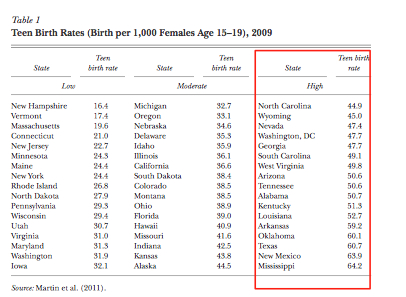July 19, 2012
The basic assumption undergirding Jason DeParle’s piece is that changes in family structure have been one of the primary drivers of growth in family income inequality over the last several decades. What is never considered is whether the causation moves in the other direction, that is, whether income and wage inequality drive some of the trends in family structure.
In a fascinating paper published in the most recent issue of the Journal of Economic Perspectives, researchers Melissa Kearney and Phillip Levine provide some evidence on this and other questions related to teen childbearing. Kearney and Levine have done the most important and interesting research on teen pregnancy in the last decade, so it is striking that DeParle doesn’t cite them in his piece. The JEP article is particularly worth reading because it summarizes findings from much of their work on the issue in an accessible way.
Looking at the relationship between state-level income inequality, which they measure using the 50-10 income ratio, and teen childbearing rates, Kearney and Levine conclude find that “women with low socioeconomic status have more teen, nonmarital births when they live in higher-inequality locations, all else equal.” Specifically, “income inequality can explain a sizable share of the geographic variation observed in the teen childbearing rate, on the order of 10 to 50 percent.” They also find the difference is due not to differences in state-level rates of teen sexual activity or pregnancy rates, but rather because the most disadvantaged teens in the high-inequality states are much less likely to have abortions. Finally, when they compare income inequality with teen childbearing at both the county level and across countries, their results on the linkage between inequality and teen births are similar.
This table, from their paper, divides states into three categories based on level of income inequality. The red box, which I’ve added, highlights the high-inequality states, which, as you can see, are all high teen birth rate states also.

What explains the link between inequality and teen childbearing? Kearney and Levine’s hypothesis is that: “[I]f girls perceive their chances at long-term economic success to be sufficiently low even if they ‘play by the rules,’ then early childbearing is more likely.” I think there is probably more going on here in terms of differences between high-inequality states and low-inequality ones that contributes to the difference in teen childbearing rates (although Kearney and Levine do look at some other factors like religiousity and partisan orientation, none of which produces any changes in their results). Here, again, Naomi Cahn and June Carbone’s Red Families vs. Blue Families: Legal Polarization and the Creation of Culture seems relevant. Regardless of the precise explanation for it, the connection Kearney and Levine find between income inequality and teen childbearing is an important one that deserves both future investigation and attention from media outlets like the New York Times.
Finally, Kearney and Levine are careful to note that theirs is an explanation of geographic disparities in teen childbearing, not trends over time. Teen pregnancy rates have declined over time. My guess is that feminism and Supreme Court decisions made in the 1960s and 1970s (including Griswold v. Connecticut and Roe v. Wade, overturning laws that prohibited contraceptives and abortion) have played an important role in that trend.






